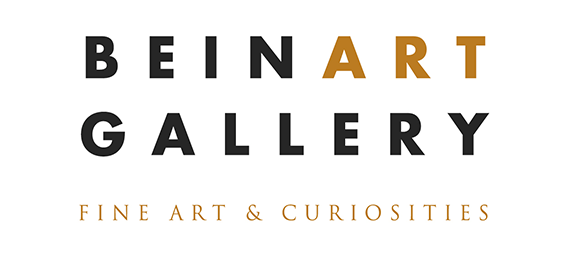Shaun Tan - "Never Argue with an Umpire" - oil on canvas
Never Argue with an Umpire
Oil on canvas by Shaun Tan (2012).
Artwork size: 86 x 76 cm (33.9" x 29.9")
Frame size: 88.5 x 78.5 x 4.7 cm (34.8" x 30.9" x 1.9")
"The guiding concept for this illustration is the way older siblings often enjoy controlling gameplay: both the choice of a game and its rules, which can be easily modified ad hoc and subject to the whim and benefit of senior players. At the same time, it’s also about the way that younger siblings voluntarily participate in such games, even when defeat is inevitable. Claims of unfairness may follow, but too late to be of any consequence. The winning or losing of games can often be particularly intense emotional experiences in childhood, and probably lays some groundwork for equally convoluted adult politics, especially at the highest levels."
"A secondary concept involves the invention of a doppelganger, the fantasy of literally making a new friend, in this case, from mechanical parts, powered by a car battery, an ‘improved’ model of the younger brother, given it has the same colour and shape. Is the robot a better player, or has the older brother been constantly revising the rules of the game to favour the machine, as evidenced by complicated chalk marks on the ground? Either way the result is the same: complete power can be exercised with the cool remoteness of an umpire. A yellow flag, a comfortably high chair, a megaphone to drown protest. No physical exertion necessary."
"The brooding background is as interesting to me as the foreground, as I’m often inspired by landscapes full of big electrical wire arrays, especially over desolate country. Aside from often being simultaneously beautiful and ugly, they suggest a fringe universe of industrial sub-consciousness beyond suburbia, largely unseen. I imagine a pervasive electrical hum and other noises of a cruder analog technology; I also imagine the smell of overheated old TVs and bitumen on a hot summer afternoon."
"This painting also draws some influence from the Australian artist Jeffrey Smart, himself perhaps influenced by American artists Edward Hopper and Charles Scheeler and Surrealists such as De Chirico. These painters excel at amplifying the stillness and disquiet of painted landscapes, particularly in urban spaces with brooding skies. Characters often seem trapped on a vast stage, playing out singular actions for eternity."
"Details to note: the very distant crow again looking on from the highest point (almost as if it is the real umpire here). The robot boy has very rigid joints, you can’t imagine moving very gracefully, more like those tennis-ball launching machines. Its head is covered with electronic eyes looking in all directions, and slightly steaming / smoking; its hands are graceless C-clamps. The cables in its back lead back to a large battery, which is kept near the older brother. At one point I had the older brother holding the battery or even controlling the robot with a joystick, but this was visually too complex, and metaphorically too direct. But I do feel that the older brother has built this machine himself with a particular purpose in mind – to win! Even if it means orchestrating a situation of artificial ‘fairness’. Anyone growing up with a sibling knows well what this is all about." —Shaun Tan




 Cart
Cart





